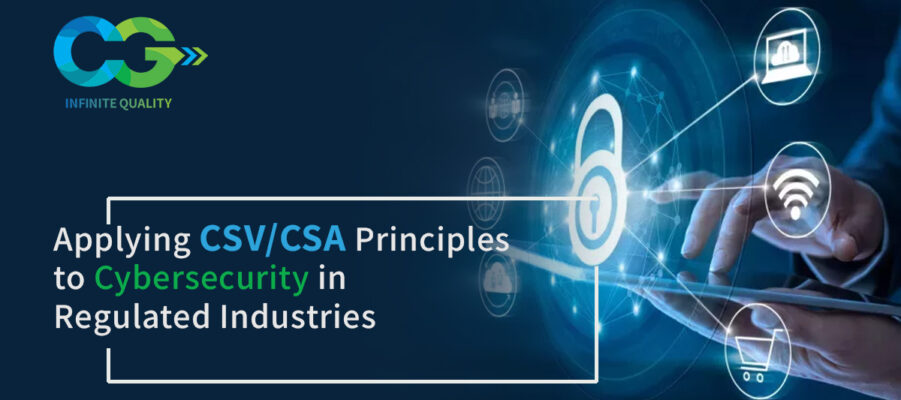Applying CSV/CSA Principles to Cybersecurity in Regulated Industries

Article Context:
In the intricate landscape of regulated industries, the synergy between Computer System Validation (CSV)/Computer Software Assurance (CSA) and Cybersecurity principles emerges as a critical cornerstone. The Lifesciences industry relies heavily on computer systems that manage many facets of manufacturing, quality assurance, and regulatory compliance. As organizations strive for digital excellence while navigating strict regulatory frameworks, understanding how these principles intertwine becomes paramount.
This blog describes the strategic integration of CSV/CSA principles in the realm of cybersecurity, unravelling the collective impact on fortifying the defenses of industries governed by stringent regulations. Join us on a journey where compliance meets innovation, and where safeguarding sensitive data is not only a necessity, but a dynamic and evolving process.
What is Computer System Validation (CSV)?
Computer System Validation is the method of establishing and maintaining compliance with relevant GxP regulations. Through implementation of concepts, techniques, and life cycle activities, the computer system can become fit for the intended purpose(s). Validation methodology shapes the framework for creating validation plans and reports, and for enforcing appropriate operational controls throughout the system's life cycle.
What is Computer Software Assurance (CSA)?
Computer Software Assurance is an innovative approach to software validation developed in accordance with FDA regulations. This strategy aims to reduce documentation demands compared to traditional CSV practices, while ensuring security and quality of the product. Pharma companies can embrace CSA guidelines by leveraging critical thinking and continuous data analysis, allowing them to maintain compliance without the burdensome documentation required by past CSV regulations.
How is Cybersecurity applied to GxP compliance?
GxP compliance refers to a set of quality regulations and guidelines that are essential in industries such as pharmaceuticals, biotechnology, medical devices, and healthcare. The "GxP" acronym covers various regulations, with the "G" typically standing for "Good" (such as Good Manufacturing Practices - GMP), and the "xP" representing various practices like Laboratory (GLP), Clinical (GCP), and Distribution (GDP). These regulations ensure that products are developed, manufactured, tested, and distributed in a consistent, safe, and effective manner, meeting the highest quality standards and regulatory requirements.
Best practices continue to change as new threats evolve. But there are some recommendations that tend to remain constant:
- Develop a risk assessment process to identify vulnerabilities in the system.
- Perform regular audits and tests of systems and networks.
- Establish an incident response plan in the event of a cyberattack.
- Conduct regular data backups for future recoveries.
Below are some of the main pillars of cybersecurity compliance:
- Network Security: Securing network access and assets through in-depth defense mechanisms.
- Cloud Security: Safeguarding cloud-based data and prioritizing cybersecurity compliance regulations.
- IoT Security: Identifying and categorizing all Internet of Things devices connected to the network.
- Mobile Security: Expanding security to include portable devices, using such tools as automated patching and device recovery.
- Endpoint Security: Protecting endpoints from attack through patching, encryption, and other strategic measures.
- Application Security: Ensuring applications are secure prior to installation; followed by continual monitoring.
- Human Security: Educating staff on secure practices to reduce the effectiveness of social engineering threats.
How do we Apply CSV/CSA Principles?
Review your compliance rules and make necessary changes to align them with the quality-centric, risk-based approach of the CSA by using the Good Automated Manufacturing Practice (GAMP) Guide to Data Integrity, which fully defines and describes CSA concepts.
In the interim, listed below are some initial steps to resolve compliance complaints right away:
Prioritise patients and products in the process
The main objective of validation is verifying that the program or system performs as intended for its users. Does it perform as you promised? Does it sufficiently accomplish its goal? All too often, this objective is overshadowed or forgotten under pressure to gather large amounts of documentation for audits/auditors. CSA clearly states that the focus should be product usability and quality, not loads of paperwork and screenshots.
Adjust validation activities based on patient risk
Not all systems are created equal in terms of how they affect a user's or patient's safety. For systems where a failure or defect poses a direct risk, CSA mandates very stringent testing and documentation; for systems that pose no risk or indirect risk, CSA requirements are lower.
For example, a labelling system requires very careful testing and documentation, because errors could result in incorrect use of medication, putting the user's safety in jeopardy. By contrast, a mechanism created to handle customer complaints affects patient safety indirectly, necessitating less stringent testing.
Adjust (or even reverse) the ratio of testing to documentation
According to FDA reports, regulated companies dedicate only 20% of their validation efforts to testing, and up to 80% to documentation. Reverse weighting is supported by CSA, which also offers instructions on how to accomplish it.
In short, the less dangerous a system is proven to be (via scripted or unscripted testing), the less documentation is required.
Take advantage of previously-completed work
Make the most of pre-validation work that has already been done, whether internally or by your suppliers, to expedite and streamline your compliance journey. Systems may not need to be thoroughly retested every time a change is made. "Take credit," the FDA's Cisco Vicenty advises. "Use it if the work has been completed."
However, before depending on a supplier's validation, make sure the source is qualified—possibly even audited as well—and set up a quality agreement.
Automate whatever you can
Automation of assurance tasks is the single most efficient option to optimise your compliance process. You'll save time, money, and effort that can then be channelled into focusing on product quality. Keep in mind that the manufacturers of some automated testing and lifecycle solutions have already verified them. You won't usually need to validate them again. (Be sure that you demand this kind of advance certification.)
Foster a critical-thinking culture
CSA and CSV differ significantly, in that CSA incorporates critical thinking into the validation process, which is central to CSA's objective. There is no one "right" way to do anything, according to CSA. With the help of automated tools that save time and money and a focused validation approach based on risk, fostering a culture of critical thinking can accelerate the delivery of more inventive and dependable goods.
Conclusion
Finally, you can be confident that implementing risk-based, quality-centered compliance techniques won't break the bank. CSV is a very important element in risk management. Among all the FDA regulatory compliance solutions, CSV can work best with the help of different technologies.
As we draw the curtain on our exploration of the potent synergy between CSV and CSA principles in fortifying cybersecurity within regulated industries, it's essential to highlight how Compliance Group Inc. (CG) stands as your strategic partner.
Our specialized services seamlessly integrate CSV and CSA methodologies, ensuring compliance with rigorous regulations. With CG, you won't only navigate the complexities, but thrive in them.
Elevate your cybersecurity posture with CG's industry expertise, where compliance meets innovation. Let CG be your guide in navigating the dynamic landscape of regulated cybersecurity.
Stay secure, stay compliant, and stay ahead with Compliance Group Inc. Discover the power of a secure future with us!
FAQ's
What is the significance of applying CSV/CSA principles to cybersecurity in regulated industries?
Applying CSV/CSA principles to cybersecurity ensures that computer systems adhere to regulatory requirements, maintain data integrity, and protect against cyber threats, thus safeguarding patient safety and regulatory compliance.
How does Computer System Validation (CSV) contribute to cybersecurity in regulated industries?
CSV ensures that computer systems used in regulated industries, such as pharmaceuticals and medical devices, are validated to meet predefined specifications, including cybersecurity requirements. This validation helps mitigate cybersecurity risks and ensures the integrity and security of data and systems.
What are the key cybersecurity principles that should be applied to CSV in regulated industries?
Key cybersecurity principles include data encryption, access controls, authentication mechanisms, audit trails, and intrusion detection systems. These principles help protect against unauthorized access, data breaches, and cyber-attacks on validated computer systems.
What are the common cybersecurity challenges faced by regulated industries in implementing CSV/CSA principles?
Common challenges include navigating complex regulatory requirements, integrating cybersecurity controls into validated computer systems, ensuring interoperability between systems, and addressing emerging cybersecurity threats and vulnerabilities.
How can organizations ensure compliance with CSV/CSA principles while addressing cybersecurity concerns in regulated industries?
Organizations can ensure compliance by conducting comprehensive risk assessments, implementing robust cybersecurity controls and protocols, conducting regular security audits and assessments, providing cybersecurity training to staff, and staying informed about emerging threats and best practices.
What are some best practices for integrating cybersecurity into CSV/CSA processes in regulated industries?
Best practices include conducting cybersecurity risk assessments, implementing defense-in-depth strategies, encrypting sensitive data, implementing multi-factor authentication, regularly updating software and systems, and establishing incident response plans.
